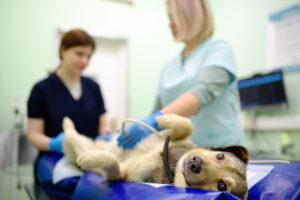How Do You Know If Your Dog Needs a C-Section?
 When your dog is pregnant, you want to do everything you can to make sure they’re healthy and happy. There’s a lot to prepare for and think about leading up to the big day, and for most dogs, pregnancy and birth are smooth sailing. However, there are times when the safest option for a dog’s birth is via cesarean section (C-section). In fact, 35.5% of female dogs have at least one C-section in their lifetime. In the Tampa Bay area, Affordable Pet Hospital is here to help with all your dog’s pregnancy and birth needs, including C-sections when necessary. In this post, we’ll discuss the signs to look out for to determine if your dog needs a C-section.
When your dog is pregnant, you want to do everything you can to make sure they’re healthy and happy. There’s a lot to prepare for and think about leading up to the big day, and for most dogs, pregnancy and birth are smooth sailing. However, there are times when the safest option for a dog’s birth is via cesarean section (C-section). In fact, 35.5% of female dogs have at least one C-section in their lifetime. In the Tampa Bay area, Affordable Pet Hospital is here to help with all your dog’s pregnancy and birth needs, including C-sections when necessary. In this post, we’ll discuss the signs to look out for to determine if your dog needs a C-section.
What is a C-Section?
A C-section is a surgical procedure that is done to assist in a birth. The surgery involves cutting into the mother’s abdominal wall and uterus, then removing the babies. In dogs, certain breeds are more likely to have difficulty giving birth naturally and thus are more likely to need a C-section, such as bulldogs and pugs. However, any dog may need a C-section, regardless of breed.
Recognizing the Need for a C-Section
It’s important to be on the lookout for the signs that a C-section may be necessary for your dog. Prompt intervention once these signs are noticed is vital to ensure a positive outcome, so contact your veterinarian immediately if you notice any of the following signs:
Prolonged Labor
One of the primary indicators that a C-section might be necessary is prolonged labor without producing a puppy. If your dog has had weak contractions for at least two hours or heavy contractions for at least 30 minutes without delivering any puppies, it’s crucial to consult a veterinarian immediately.
Distress in the Mother
Any sign of distress in the mother, such as fever, vomiting, excessive panting, lethargy, or disorientation, could also indicate the need for a C-section.
Breed Specific Risks
As mentioned above, there are certain breeds that are more susceptible to needing a C-section. This is mainly because these breeds have larger heads and broad shoulders, making them harder to deliver naturally. Discuss any breed concerns you may have with your vet to make a plan ahead of time and ease any anxiety.
Veterinary Recommendations
Your veterinarian’s advice is crucial. During prenatal visits, your vet can determine how many puppies your dog is expecting, their position, and their size relative to the birth canal. Your vet may also use diagnostic tools to get more information about the safest delivery options. Always consider your vet’s advice when preparing for your dog’s delivery day.
Preparing for a C-Section
If a C-section is needed for your dog, your vet will give you all the information you’ll need to prepare your pooch for the surgery. This usually includes having the dog fast for several hours prior to the procedure and discussing anesthesia options. They will also explain what will happen during and after the procedure. This is a good time to ask questions to help you better understand the process.
Aftercare for Your Dog
Taking good care of your dog and her new pups is vital to ensuring their optimal health. Your vet will give you a step-by-step of instructions on how to care for your dog post-surgery, so be sure to follow these instructions carefully. This will include monitoring for signs of infection, such as pain, redness, swelling, or a foul-smelling discharge at the incision site. Your vet will also help with tips on how to help your dog nurse and care for the new little ones.
Trust Affordable Pet Hospital in Tampa Bay for your Dog’s Pregnancy Needs
Being prepared for all possible scenarios during your dog’s pregnancy will help your and your expecting pup feel more at ease. If you’re in the Tampa Bay area and need pregnancy care for your dog, Affordable Pet Hospital is here to help. Contact us at 813-991-9898 or request an appointment online to start your dog’s prenatal care today.

